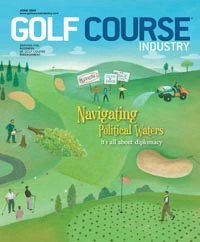|
|
As temperatures escalate, keeping greens fast and under as little stress as possible can be a mammoth challenge. However, there’s a feasible way to allow superintendents to have it all, says John Sorochan, Ph.D. The associate professor of turfgrass science and management from the University of Tennessee shared his insight with superintendents at a Stomp Out Stress seminar sponsored by Bayer Environmental Science at the Atlanta Athletic Club.
Golf course greens in the Southeast face the problem of indirect heat stress, which means temperatures are warmer than they need to be for optimum growth during an extended period of time, Sorochan says. The need for fast, smooth greens leads to frequent mowing, which doesn’t help the situation.
“The way the game has evolved, people are going down to one-eighth and one-tenth of an inch,” Sorochan says about heights of cut. “The return is disease and stress.”
Frequent mowing at a low height in the hot weather exacerbates the problem because it places physiological stress on the turf, decreasing its recuperative ability. This dilemma encouraged Sorochan’s team at UT to look at ways to maintain the quality greens without causing as much damage. The research determined that alternately mowing (with a Toro walk-behind mower) and rolling (with a DMI Speed Roller), each three days a week, helped maintain the high quality and speed of the greens.
“That day we’re not mowing we have that much more surface area for photosynthetic activity,” Sorochan says.
The other methods tested – simply mowing six days a week, or mowing six days and rolling three – decreased the turf quality. These trials were incorporated with regular cultural practices.
Superintendents might wonder what the solution will do to their budgets. It can be a positive thing, according to a survey Sorochan’s group conducted. Alternately mowing and rolling can save the facility money, or, more realistically, free up money to be spent on another piece of course maintenance equipment, depending on the type of facility.
The average private course spends about 70 cents per minute more than public courses on mowing, so private courses tend to benefit more from Sorochan’s plan. The savings can be as much as $22,000 for private courses that use walk-behind mowers when they alternate mowing and rolling. Public courses that use walk-behinds see a significant savings, too, but not as much – about $14,000.
“Now you can afford to buy that topdressing sand again that you couldn’t afford because trucking prices went through the roof,” Sorochan says.
High-quality, stress-free greens and topdressing sand – maybe courses can have it all. GCI

Explore the June 2008 Issue
Check out more from this issue and find your next story to read.
Latest from Golf Course Industry
- From the publisher’s pen: Conscientious of a bigger role
- Bernhard and Company partners with Laguna Golf Phuket
- Terre Blanche showcases environmental stewardship
- VIDEO: Introducing our December issue
- Bernhard and Company introduces Soil Scout
- Nu-Pipe donates to GCSAA Foundation’s Centennial Campaign
- GCSAA enhances golf course BMP tool
- Melrose leadership programs sending 18 to 2026 GCSAA Conference and Trade Show






